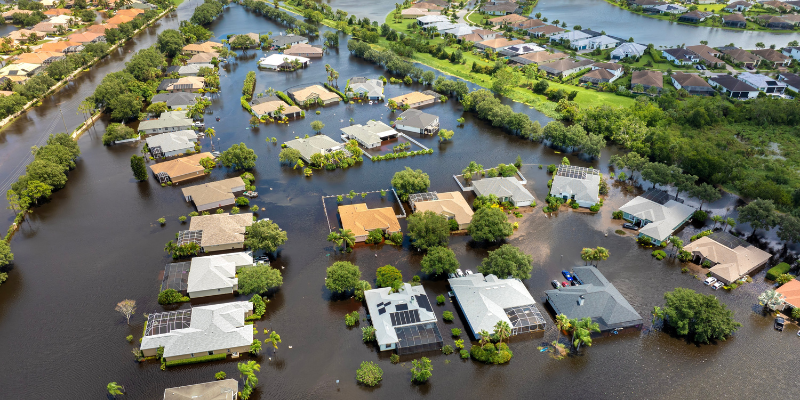The increasing frequency and severity of natural disasters due to climate change are reshaping the insurance landscape. From hurricanes and wildfires to extreme flooding resulting from these and other ecological disruptions, financial institutions that lend in high-risk regions are finding it more challenging to provide financing as their borrower struggle to secure necessary insurance coverage at reasonable prices. For banks and credit unions engaged in commercial lending—especially for construction, fix-and-flip projects, and other real estate investments—this shift necessitates a fundamental reassessment of insurance covenants within closing documents.
The Insurance Industry in Crisis
Traditionally, financial institutions have relied on insurance as a critical risk mitigation tool. Lenders rely on taking an assignment of these insurance policies and the insurance proceeds to be paid out when a collateral property is damaged or destroyed by fire, flood or another hazard. However, as disasters become more frequent and destructive, insurers are either dramatically increasing premiums or outright refusing to underwrite policies in high-risk areas. For example, California’s Insurance Commissioner is considering State Farm’s request for a 22% premium increase following devastating wildfires, thus making the cost of such insurance economically unavailable to many property owners and other developers. This is of particular concern in states such as California where the law requires that insurance proceeds be applied first to the rebuilding of a damaged or destroyed building if reconstruction is at all feasible, rather than allowing a lender to simply apply such proceeds to the repayment of the outstanding loan against the property.
While flood insurance remains federally regulated and required in designated flood zones, there is no similar mandate for fire or hurricane insurance. This means insurers have the discretion to deny coverage altogether, leaving borrowers and lenders in a precarious position. Deloitte, for example, has provided insurance agencies and financial institutions with “Evolving industry operating models to build the future of insurance” guidance. The financial institutions we work with are already adapting by scrutinizing disaster zone classifications and insurance options more carefully before issuing loans.
Rethinking Insurance Covenants in Closing Documents
Given this shifting landscape, banks and credit unions must reassess their insurance covenants to ensure they adequately address the evolving risk profile of their loan portfolios. We already are seeing banks and credit unions reassess their insurance covenant models for consumer lending. Similarly, traditional insurance requirements may no longer be sufficient for commercial lending, and financial institutions should consider the following strategies:
- Expanded Insurance Provisions: Given that insurance availability and costs can fluctuate, lenders should incorporate flexible provisions that account for scenarios where coverage becomes prohibitively expensive or unavailable.
- Disaster Zone Risk Analysis: Lenders should integrate FEMA’s latest risk maps and other climate risk assessment tools into their underwriting processes to evaluate exposure before closing a loan.
- Reserve Requirements: In cases where insurance may be costly or limited, lenders might require borrowers to establish a reserve fund. Similar to how reserves are set aside for major building repairs (such as HVAC or roof replacements), this approach can provide a buffer for unexpected costs related to disaster recovery.
- Construction Loan Covenants: For new developments, lenders should consider covenants that require borrowers to obtain additional coverage if a property’s risk profile changes over time. This forward-looking approach ensures continued protection in the event of evolving climate conditions.
- Ongoing Risk Monitoring: Given the unpredictability of climate-related insurance trends, financial institutions should maintain a mechanism for monitoring changes in insurance availability and cost, adjusting their risk strategies accordingly.
How GoDocs Helps Navigate This New Reality
GoDocs understands the challenges lenders face in this evolving insurance landscape. That’s why we’ve expanded our capabilities to support financial institutions with robust, adaptable insurance provisions in GoDocs’ commercial closing documents. Our solutions ensure that lenders have the flexibility to address insurance challenges, whether through pre-configured document options or fully customized financial covenants.
With GoDocs, lenders can seamlessly integrate enhanced insurance clauses that anticipate market fluctuations and potential gaps in coverage. Our platform supports a proactive risk management approach, helping financial institutions make informed lending decisions while safeguarding their portfolios against unforeseen insurance crises.
Preparing for an Uncertain Future
Despite these challenges, commercial lending in disaster-prone areas will continue. Borrowers will still need capital, and lenders will need to find ways to mitigate risk. By strengthening insurance covenants and integrating more adaptive risk management strategies, financial institutions can protect their investments while continuing to serve high-risk markets.
GoDocs is committed to providing the tools and expertise needed to navigate these complex changes. Whether you need standardized solutions or customized provisions, our platform delivers the flexibility and security required to manage risk in an era of climate uncertainty.
Stay ahead of the risk. Contact GoDocs today to learn how we can help fortify your commercial lending practices with smarter, more adaptable insurance provisions.
Head of Business Strategies & Partnerships









